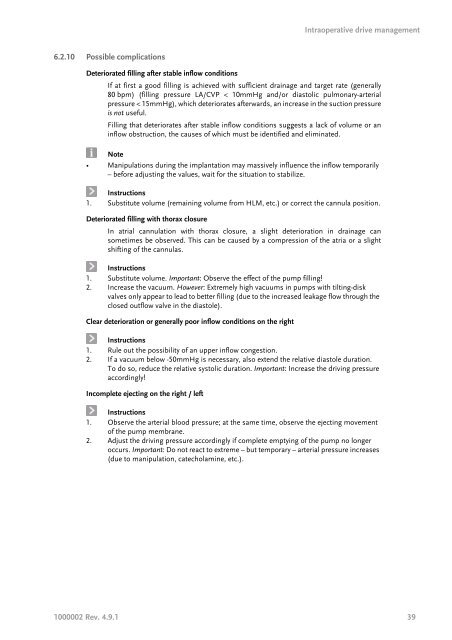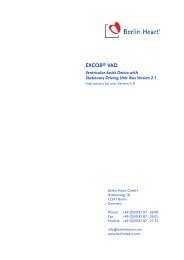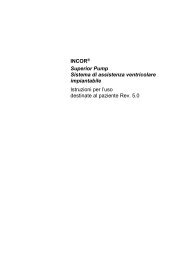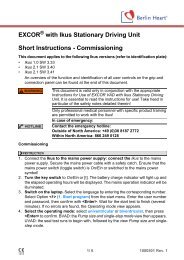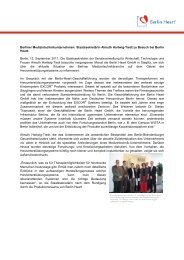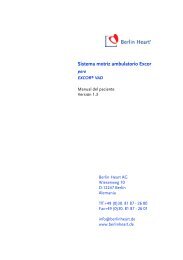Instructions for use: Ikus - Berlin Heart
Instructions for use: Ikus - Berlin Heart
Instructions for use: Ikus - Berlin Heart
Create successful ePaper yourself
Turn your PDF publications into a flip-book with our unique Google optimized e-Paper software.
6.2.10 Possible complications<br />
Intraoperative drive management<br />
Deteriorated filling after stable inflow conditions<br />
If at first a good filling is achieved with sufficient drainage and target rate (generally<br />
80 bpm) (filling pressure LA/CVP < 10mmHg and/or diastolic pulmonary-arterial<br />
pressure < 15mmHg), which deteriorates afterwards, an increase in the suction pressure<br />
is not <strong>use</strong>ful.<br />
Filling that deteriorates after stable inflow conditions suggests a lack of volume or an<br />
inflow obstruction, the ca<strong>use</strong>s of which must be identified and eliminated.<br />
Note<br />
• Manipulations during the implantation may massively influence the inflow temporarily<br />
– be<strong>for</strong>e adjusting the values, wait <strong>for</strong> the situation to stabilize.<br />
<strong>Instructions</strong><br />
1. Substitute volume (remaining volume from HLM, etc.) or correct the cannula position.<br />
Deteriorated filling with thorax closure<br />
In atrial cannulation with thorax closure, a slight deterioration in drainage can<br />
sometimes be observed. This can be ca<strong>use</strong>d by a compression of the atria or a slight<br />
shifting of the cannulas.<br />
<strong>Instructions</strong><br />
1. Substitute volume. Important: Observe the effect of the pump filling!<br />
2. Increase the vacuum. However: Extremely high vacuums in pumps with tilting-disk<br />
valves only appear to lead to better filling (due to the increased leakage flow through the<br />
closed outflow valve in the diastole).<br />
Clear deterioration or generally poor inflow conditions on the right<br />
<strong>Instructions</strong><br />
1. Rule out the possibility of an upper inflow congestion.<br />
2. If a vacuum below -50mmHg is necessary, also extend the relative diastole duration.<br />
To do so, reduce the relative systolic duration. Important: Increase the driving pressure<br />
accordingly!<br />
Incomplete ejecting on the right / left<br />
<strong>Instructions</strong><br />
1. Observe the arterial blood pressure; at the same time, observe the ejecting movement<br />
of the pump membrane.<br />
2. Adjust the driving pressure accordingly if complete emptying of the pump no longer<br />
occurs. Important: Do not react to extreme – but temporary – arterial pressure increases<br />
(due to manipulation, catecholamine, etc.).<br />
1000002 Rev. 4.9.1 39


